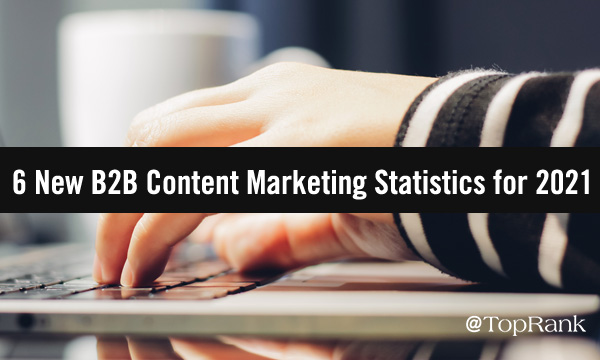
“You can come up with statistics to prove anything, Kent. Forty percent of all people know that.” – Homer Simpson
Homer might be right, generally speaking. But I still maintain that good, accurate, timely statistics from trusted sources can serve as vital guideposts and benchmarking tools, especially when it comes to business strategy.
This certainly applies in my own corner of the business world: the fast-changing and critically important field of B2B content marketing.
Trends in content marketing tend to reflect broader truths, since we’re talking about the ways in which companies and customers interact and communicate. Because of this, I like to keep a close eye on new research and data as it surfaces, filing away nuggets that strike me as especially telling.
Today, I’ll share six new B2B content marketing statistics that everyone should know.
6 Eye-Opening B2B Content Marketing Statistics for 2021
These stats highlight many of the challenges, opportunities, and changes unfolding here in 2021.
#1: Businesses are the most trusted institution for information in 2021. (Source: Edelman)
Edelman’s 2021 Trust Barometer shows that the business sector has risen above government, media, and NGOs in its Trust Index. Edelman also found that business is now seen as the institution that is both competent and ethical.
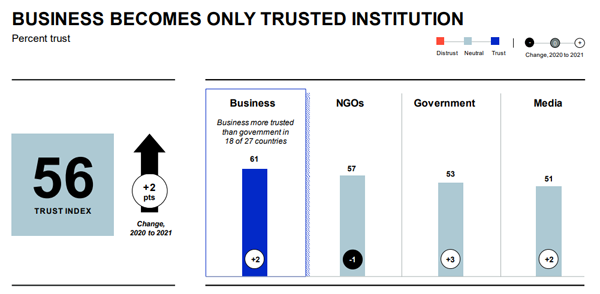
Needless to say, this is a big moment for content marketers. Distrust is running rampant among misinformation, uncertainty and anxiety across the globe. People are looking to businesses for credible, clear, and accurate insights and guidance. As marketers, we must harness this opportunity to earn and solidify this trust.
How can we best do so? Edelman’s survey results point to a clear answer: by vigorously guarding information quality and filtering out the noise.
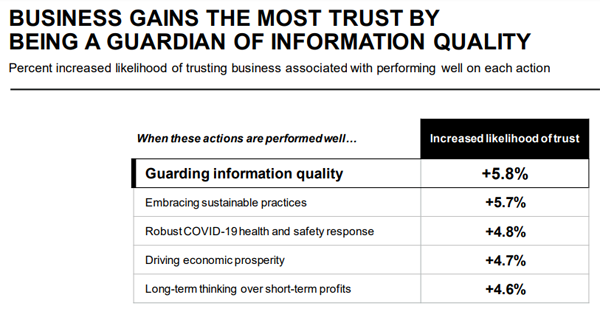
“People are looking to businesses for credible, clear, and accurate insights and guidance. As marketers, we must harness this opportunity to earn and solidify this trust.” — Nick Nelson @NickNelsonMN Click To Tweet
#2: 88% of marketers say collecting first-party data is a priority in 2021. (Source: Merkle)
This comes from Merkle’s 2021 Customer Engagement Report, highlighting a key frontier for informing content strategies this year. While third-party data and insights like those we’ve aggregated here are useful, nothing can quite match the relevance and impact of information drawn from your own customers and digital experiences.
Heightening data privacy regulations are playing a major role in motivating these initiatives, according to Merkle’s research. The report also points to a rise in “zero-party data,” which includes “transaction intentions, preference data, personal context, and what the customer thinks about the company.”
Per Merkle: “Marketers don’t have to infer customer preferences or behavior through secondary behavior but are instead explicitly told, straight from the source. The best zero-party data is when the customers trust the brand and are willing to volunteer their data with the understanding that it will improve their experience.”
#3: Mobile device usage rose dramatically in 2020. (Souce: App Annie)
Surely this comes as no surprise. Deprived of the ability to congregate in person, many of us increased our reliance on different forms of connection and entertainment. App Annie’s State of Mobile 2021 report found that mobile adoption saw two-to-three years worth of advancement in 12 months during 2020, with mobile time surpassing live TV.
Substantial increases were seen across the board globally:
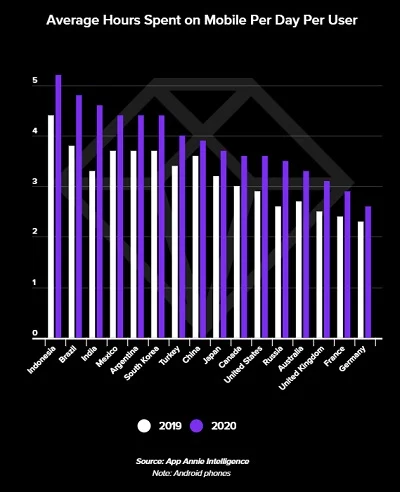
App Annie also shared data around the most-used social networking apps in 2020. No. 1 on the list may surprise you:
- TikTok
- WhatsApp Messenger
- Facebook Messenger
While these apps tend to be utilized more in the B2C realm for marketing purposes, it’s valuable to note the popularity and traction.
#4: Brands are using Instagram Stories more than ever. (Source: Rival IQ)
On that note, the newly released 2021 Instagram Stories Benchmark Report from social analytics firm Rival IQ casts light on usage and engagement trends around Instagram Stories, a fast-rising channel that holds some intrigue for B2B brands. As mentioned above, Instagram is a traditionally B2C-centric marketing app, but given the growing adoption and the amount of time people spend on it, no marketer should ignore it. I wrote here a couple years ago about why Instagram Stories were generating B2B buzz, and now that buzz is loudening.
For those who are interested in dabbling, Rival IQ offers this advice based on its research findings: “Focus on creating a few really engaging, dynamic frames to start off your Story. If your brand can hook viewers early with great content, it’ll improve your retention and turn your followers into fans.”
#5: Most B2B marketers say the pandemic had a meaningful impact on their strategies. (Source: CMI/MarketingProfs)
The 2021 B2B Content Marketing Benchmarks, Budgets and Trends report placed a special emphasis on understanding how organizations responded and adapted to COVID-19. Seventy percent of respondents in the survey from Content Marketing Institute and MarketingProfs said the pandemic had a major or moderate impact on their content strategy, with most describing their adjustments as a combination of short-term and long-term.
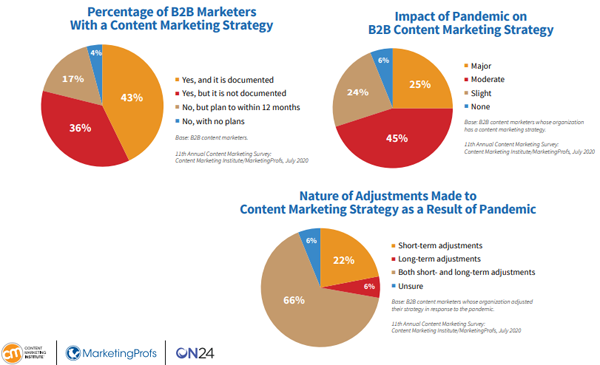
When asked specifically about the most common changes made in response to COVID-19, these were the top responses from B2B marketers:
- Changed targeting/messaging strategy (70%)
- Adjusted editorial calendar (64%)
- Changed content distribution/promotion strategy (53%)
- Changed website (40%)
- Put more resources toward social media/online communities (40%)
#6: The top barriers to creating great B2B content are workload and changing priorities. (Source: Radix Communications)
Radix Communications surveyed more than 100 B2B marketers to learn which obstacles loom largest in this year. The most commonly cited barriers in the way of great content were changing priorities and workload, although respondents were more likely to name interference and resources as a “big problem” than workload.
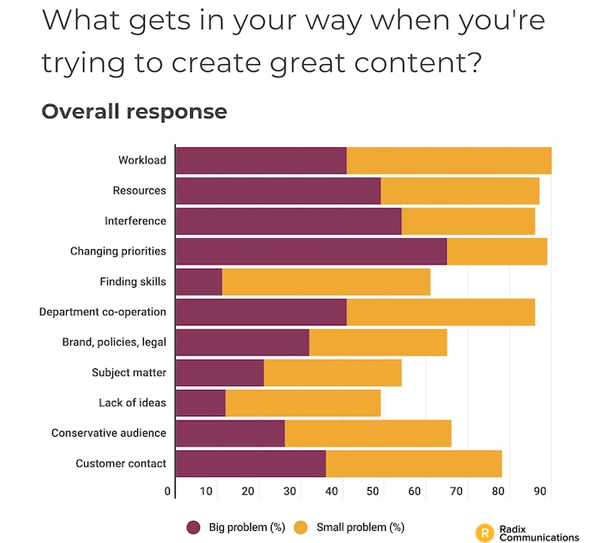
Another finding in Radix’s research: “B2B marketers who can’t talk to customers are 27% less likely to be happy with their content’s business results.” This ties back to the prioritization of first-party data and gathering direct insight from the audience.
B2B Content Marketing by the Numbers
Homer Simpson wasn’t entirely off base. People can dig up statistics to make almost any type of case. But here, the numbers only confirm trends and realities that most B2B content marketers are already experiencing. Trust hangs in the balance; data is growing both more important and more nuanced; mobile and social media usage have exploded; and evolving priorities create new challenges for planning.
We hope that the context provided by these B2B content marketing statistics helps you as you find your way in the new landscape. For more forward-looking insight to guide your strategy, check out Lee Odden’s post on the Top B2B Marketing Trends for 2021.

Comments are Closed